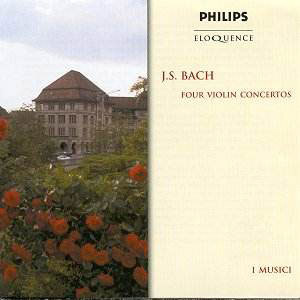I Musici recorded these concertos over a three-year
period, recordings that are now over forty years old. Of the soloists
it’s Felix Ayo who is probably the most famous but violinist Roberto
Michelucci acquits himself very well in the bulk of the disc, in which
solid tempos and superior technique bring their own rewards. The opening
allegro of the E Major Concerto is slow, with discreet diminuendos but
there is very occasionally a stolidity to the bass line that can impede
the natural flow of the line. Nevertheless I Musici are commendable
in the way they manage to bring out - but not flaunt - the harmonic
implications of these works. Michelucci employs some very quick slides
in the Adagio of the E Major and his trills are well taken if not of
electric velocity. An expressive orchestral diminuendo before the violinist’s
entry graces the concluding Allegro of the work but there is what sounds
like a bad edit at 2’47 here. In the A Minor Concerto Michelucci is
again calculatingly slow but never mechanically so and there is much
to enjoy in the contrast between the solo violin and the deep, lean
cellos and basses – the orchestral strings’ descent at 6’30 is both
affecting and expressive in the Andante.
Michelucci is joined by Ayo for a pleasing performance
of the Double Concerto. They take a predictably deliberate tempo and
are careful to give full articulation to note values. Whereas at their
speed the results can again sound somewhat sluggish there is a compensatory
aristocracy of phrasing and address to the playing. The extreme diminuendo
at 8’00, towards the end of the slow movement, is the apotheosis of
their approach to these works, which are constantly illuminated by moments
of plasticity of phrasing or interior drama – naturally much of this
will be unattractive to the more anaemic listener but there are rewards
in hearing the sometimes surprising angularities of Bach’s writing that
become exposed in performances of this kind. Much harmonic and motivic
detail is opened up and it’s intriguing to hear. I enjoyed the concerto
for Violin and Oboe. It’s an affectionate but not affecting performance
(unlike the almost contemporaneous Menuhin-Goossens recording which
was both in profusion). The harpsichord continuo is audible – just –
at a jog trot concluding Allegro. Altogether this is a pleasing conspectus
of I Musici’s evolving approach to Bach playing at the dawn of the 1960s.
Jonathan Woolf


